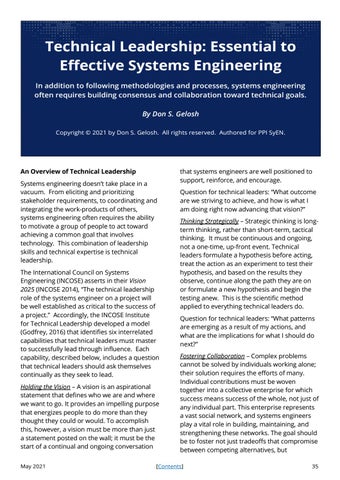Technical Leadership: Essential to Effective Systems Engineering In addition to following methodologies and processes, systems engineering often requires building consensus and collaboration toward technical goals. By Don S. Gelosh Copyright © 2021 by Don S. Gelosh. All rights reserved. Authored for PPI SyEN.
An Overview of Technical Leadership Systems engineering doesn’t take place in a vacuum. From eliciting and prioritizing stakeholder requirements, to coordinating and integrating the work-products of others, systems engineering often requires the ability to motivate a group of people to act toward achieving a common goal that involves technology. This combination of leadership skills and technical expertise is technical leadership. The International Council on Systems Engineering (INCOSE) asserts in their Vision 2025 (INCOSE 2014), “The technical leadership role of the systems engineer on a project will be well established as critical to the success of a project.” Accordingly, the INCOSE Institute for Technical Leadership developed a model (Godfrey, 2016) that identifies six interrelated capabilities that technical leaders must master to successfully lead through influence. Each capability, described below, includes a question that technical leaders should ask themselves continually as they seek to lead. Holding the Vision – A vision is an aspirational statement that defines who we are and where we want to go. It provides an impelling purpose that energizes people to do more than they thought they could or would. To accomplish this, however, a vision must be more than just a statement posted on the wall; it must be the start of a continual and ongoing conversation May 2021
that systems engineers are well positioned to support, reinforce, and encourage. Question for technical leaders: “What outcome are we striving to achieve, and how is what I am doing right now advancing that vision?” Thinking Strategically – Strategic thinking is longterm thinking, rather than short-term, tactical thinking. It must be continuous and ongoing, not a one-time, up-front event. Technical leaders formulate a hypothesis before acting, treat the action as an experiment to test their hypothesis, and based on the results they observe, continue along the path they are on or formulate a new hypothesis and begin the testing anew. This is the scientific method applied to everything technical leaders do. Question for technical leaders: “What patterns are emerging as a result of my actions, and what are the implications for what I should do next?” Fostering Collaboration – Complex problems cannot be solved by individuals working alone; their solution requires the efforts of many. Individual contributions must be woven together into a collective enterprise for which success means success of the whole, not just of any individual part. This enterprise represents a vast social network, and systems engineers play a vital role in building, maintaining, and strengthening these networks. The goal should be to foster not just tradeoffs that compromise between competing alternatives, but
[Contents]
35
